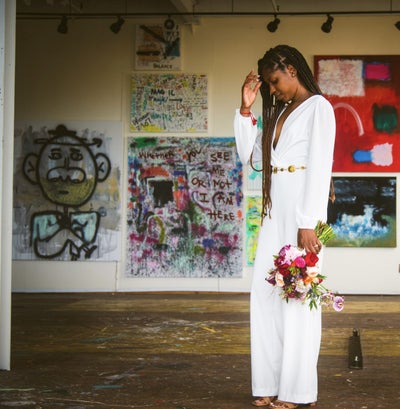Hillbillies, poverty and whiteness are common terms many people associate with American Appalachia. Not Kreneshia Whiteside-McGee, though. When peeling back the layers of Appalachian culture, she was able to identify a swath of different colors at play. Namely, black.
Y’all Don’t Hear Me: The Black Appalachia is one of her latest multi-media exhibitions where she displayed the works of seasoned and emerging artists that highlights the values and legacy of Black Appalachian culture. “Black” and “Appalachian” are an oxymoronic pair, but to Whiteside McGee, the cultures were a perfect meld.
That’s what makes her divinely aligned for the career path she chose as an art curator. The role technically calls for someone to help outfit galleries with pieces for shows and exhibitions but beyond that, the true calling of a curator is to hold space for a vision beyond what’s normally seen.
Born in Chatanooga, Tennessee, everyone around her knew she had a predilection for the arts. So much so, Whiteside-McGee’s mother refused to let her bright, creative daughter attend a traditional school, but instead enrolled her in Chattanooga High School Center for Creative Arts to help hone her artistic sensibilities. After graduating in 2012 she went on to pursue a college education in art curation, something that was seldom heard of or spoken about in Black circles, but White-McGee knew it was the path for her.
“I was just able to see the beauty in most things,” she told me.
We’d met after sitting next to one another at a panel discussion during this year’s Art Basel, an annual convening and celebration of creativity held in Miami’s Wynwood area.
“I love your fan,” she told me, as I tried to combat Florida with the hand-crafted tool that dawned traditional Ankara designs. I explained that it was made by a Ghanaian artisan and it can’t be ordered online, unfortunately.
“I assumed it was one-of-a-kind,” she said knowingly. “Unique things usually catch my eye.”

She wound up sharing with me that she’d curated all of the artwork that dawned the walls of the event space.
“It’s all done by my husband,” she said, pointing to her partner, a fellow Tennesseean and fine artist that goes by the name Genesis The Grey Kid, who was across the room.
When I later asked how they’d met, she said she was able to instantly see a quiet, pure beauty in him while at an art show years earlier that led to love and eventual life partnership. This sounded akin to how she handles her career in art curation, with intuitive recognition and fearlessness, two qualities that are almost required for success in the world of art consulting. Particularly as a Black woman. For this, I called her a unicorn.
“I agree with you on that,” she responded. “It’s not easy for someone who looks like me to move in circles that can sometimes really lean into the bourgeoisie of the high arts, and question things that may not be questioned if I wasn’t who I am.”
She continued: “Fortunately though, art enthusiasts love seeing diversity and amplifying underrepresented voices in artistry so getting to highlight Black artists have never been a problem. It’s the business of art that can be a bit tricky.”
Data shows that 59.6% of all curators are women, while 40.4% are men. The average age of an employed curator is 44 years old. The most common ethnicity of curators is White (80.0%), followed by Hispanic or Latino (8.0%), Black or African American (4.4%) and Asian (4.3%).
So, literally to be young, Black, a woman and an art curator is indeed incredibly rare. Fortunately, Whiteside-McGee was able t0 push through barriers and has worked with the Association for Visual Arts, and Frist Museum among many other organizations. She now runs her own art consultancy and helps bridge gaps between artists and galleries.
“I’m always going to be about seeing the beauty in all forms of expression, particularly those intersectional with Black culture and that feels really good.”
The post Eye Of The Beholder: This Art Curator Has Built A Career Through Recognizing Black Expression appeared first on Essence.


0 Commentaires